Legal Framework: Human Rights Act 1998 and Equality Act 2010 Analysis
VerifiedAdded on 2023/01/06
|8
|2173
|77
Report
AI Summary
This report provides a comprehensive analysis of the Human Rights Act 1998 and the Equality Act 2010, focusing on their influence over criminal fraud investigations within the UK legal framework. The introduction defines human rights and their significance, followed by a detailed exploration of both Acts. The Human Rights Act 1998 incorporates the European Convention on Human Rights (ECHR) into UK law, ensuring the protection of individual rights. The Equality Act 2010 consolidates and updates anti-discrimination laws, safeguarding individuals against unfair treatment based on protected characteristics like age, gender, and race. The report examines prohibited conduct, including direct and indirect discrimination, and discusses justifications and positive action allowed under the Equality Act. It also highlights the role of the Crown Prosecution Service (CPS) in upholding human rights during criminal prosecutions, emphasizing the application of ECHR principles. The conclusion summarizes the Acts' importance in protecting individuals from discrimination and ensuring fair treatment in criminal proceedings.
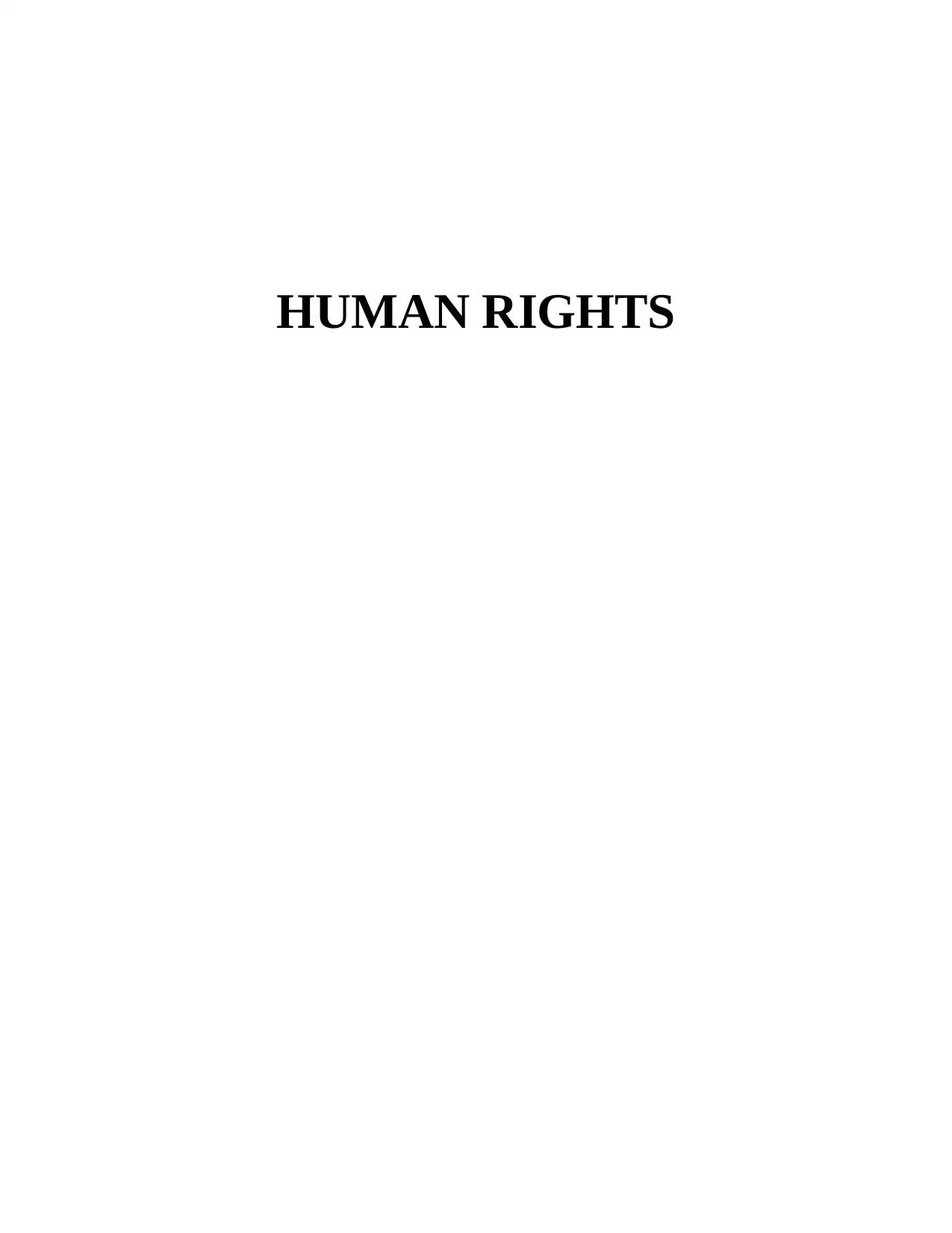
HUMAN RIGHTS
Paraphrase This Document
Need a fresh take? Get an instant paraphrase of this document with our AI Paraphraser
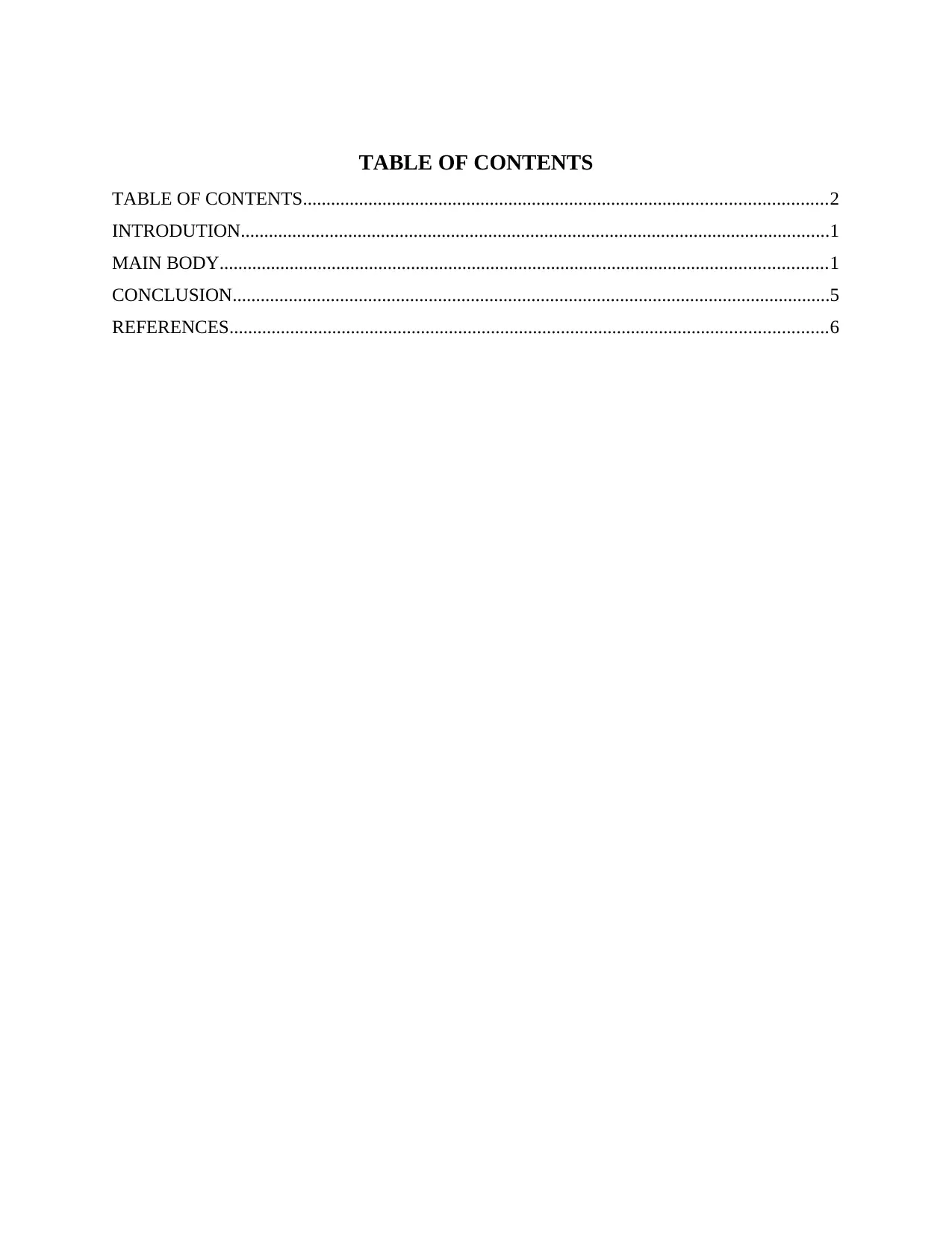
TABLE OF CONTENTS
TABLE OF CONTENTS................................................................................................................2
INTRODUTION..............................................................................................................................1
MAIN BODY..................................................................................................................................1
CONCLUSION................................................................................................................................5
REFERENCES................................................................................................................................6
TABLE OF CONTENTS................................................................................................................2
INTRODUTION..............................................................................................................................1
MAIN BODY..................................................................................................................................1
CONCLUSION................................................................................................................................5
REFERENCES................................................................................................................................6
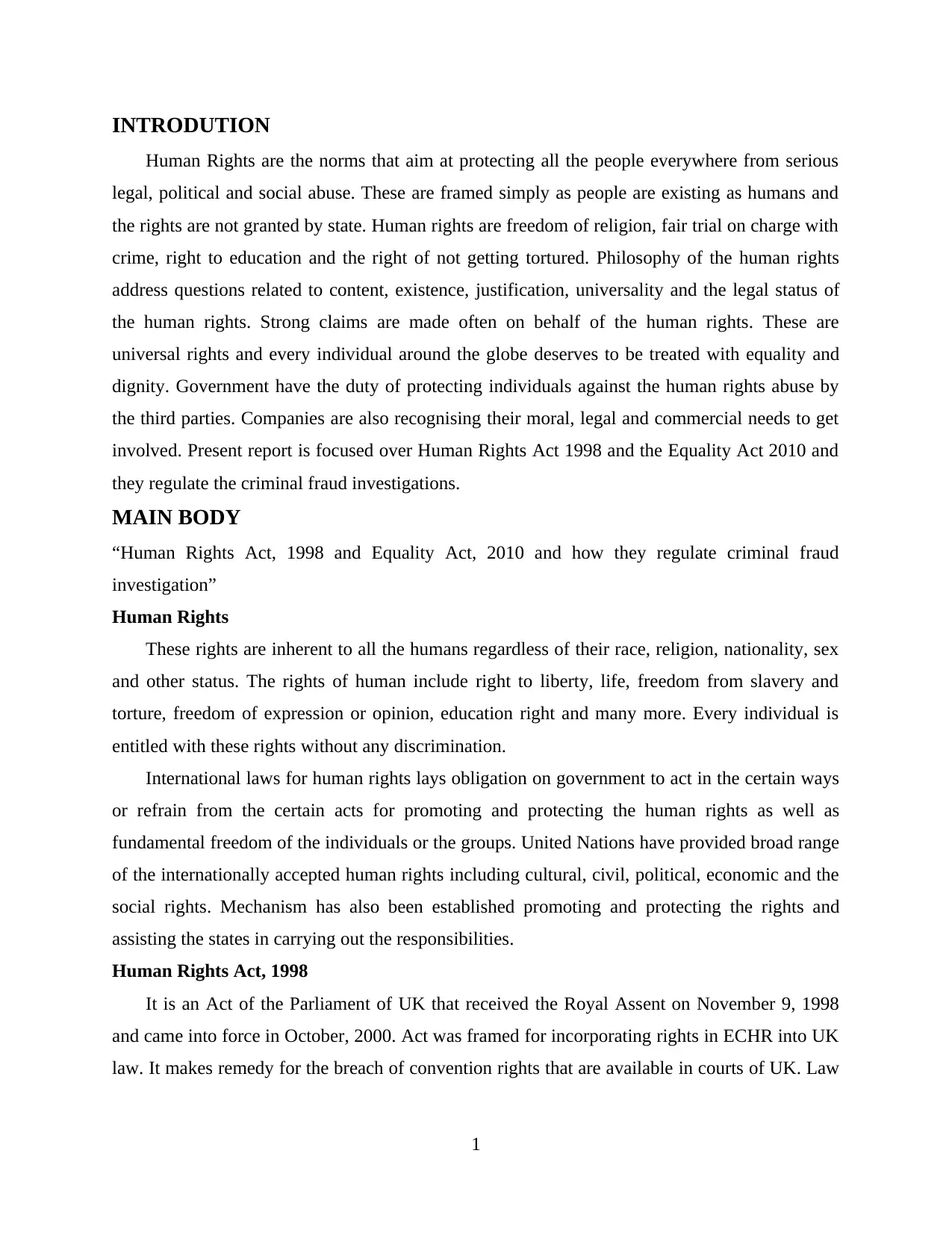
INTRODUTION
Human Rights are the norms that aim at protecting all the people everywhere from serious
legal, political and social abuse. These are framed simply as people are existing as humans and
the rights are not granted by state. Human rights are freedom of religion, fair trial on charge with
crime, right to education and the right of not getting tortured. Philosophy of the human rights
address questions related to content, existence, justification, universality and the legal status of
the human rights. Strong claims are made often on behalf of the human rights. These are
universal rights and every individual around the globe deserves to be treated with equality and
dignity. Government have the duty of protecting individuals against the human rights abuse by
the third parties. Companies are also recognising their moral, legal and commercial needs to get
involved. Present report is focused over Human Rights Act 1998 and the Equality Act 2010 and
they regulate the criminal fraud investigations.
MAIN BODY
“Human Rights Act, 1998 and Equality Act, 2010 and how they regulate criminal fraud
investigation”
Human Rights
These rights are inherent to all the humans regardless of their race, religion, nationality, sex
and other status. The rights of human include right to liberty, life, freedom from slavery and
torture, freedom of expression or opinion, education right and many more. Every individual is
entitled with these rights without any discrimination.
International laws for human rights lays obligation on government to act in the certain ways
or refrain from the certain acts for promoting and protecting the human rights as well as
fundamental freedom of the individuals or the groups. United Nations have provided broad range
of the internationally accepted human rights including cultural, civil, political, economic and the
social rights. Mechanism has also been established promoting and protecting the rights and
assisting the states in carrying out the responsibilities.
Human Rights Act, 1998
It is an Act of the Parliament of UK that received the Royal Assent on November 9, 1998
and came into force in October, 2000. Act was framed for incorporating rights in ECHR into UK
law. It makes remedy for the breach of convention rights that are available in courts of UK. Law
1
Human Rights are the norms that aim at protecting all the people everywhere from serious
legal, political and social abuse. These are framed simply as people are existing as humans and
the rights are not granted by state. Human rights are freedom of religion, fair trial on charge with
crime, right to education and the right of not getting tortured. Philosophy of the human rights
address questions related to content, existence, justification, universality and the legal status of
the human rights. Strong claims are made often on behalf of the human rights. These are
universal rights and every individual around the globe deserves to be treated with equality and
dignity. Government have the duty of protecting individuals against the human rights abuse by
the third parties. Companies are also recognising their moral, legal and commercial needs to get
involved. Present report is focused over Human Rights Act 1998 and the Equality Act 2010 and
they regulate the criminal fraud investigations.
MAIN BODY
“Human Rights Act, 1998 and Equality Act, 2010 and how they regulate criminal fraud
investigation”
Human Rights
These rights are inherent to all the humans regardless of their race, religion, nationality, sex
and other status. The rights of human include right to liberty, life, freedom from slavery and
torture, freedom of expression or opinion, education right and many more. Every individual is
entitled with these rights without any discrimination.
International laws for human rights lays obligation on government to act in the certain ways
or refrain from the certain acts for promoting and protecting the human rights as well as
fundamental freedom of the individuals or the groups. United Nations have provided broad range
of the internationally accepted human rights including cultural, civil, political, economic and the
social rights. Mechanism has also been established promoting and protecting the rights and
assisting the states in carrying out the responsibilities.
Human Rights Act, 1998
It is an Act of the Parliament of UK that received the Royal Assent on November 9, 1998
and came into force in October, 2000. Act was framed for incorporating rights in ECHR into UK
law. It makes remedy for the breach of convention rights that are available in courts of UK. Law
1
⊘ This is a preview!⊘
Do you want full access?
Subscribe today to unlock all pages.

Trusted by 1+ million students worldwide
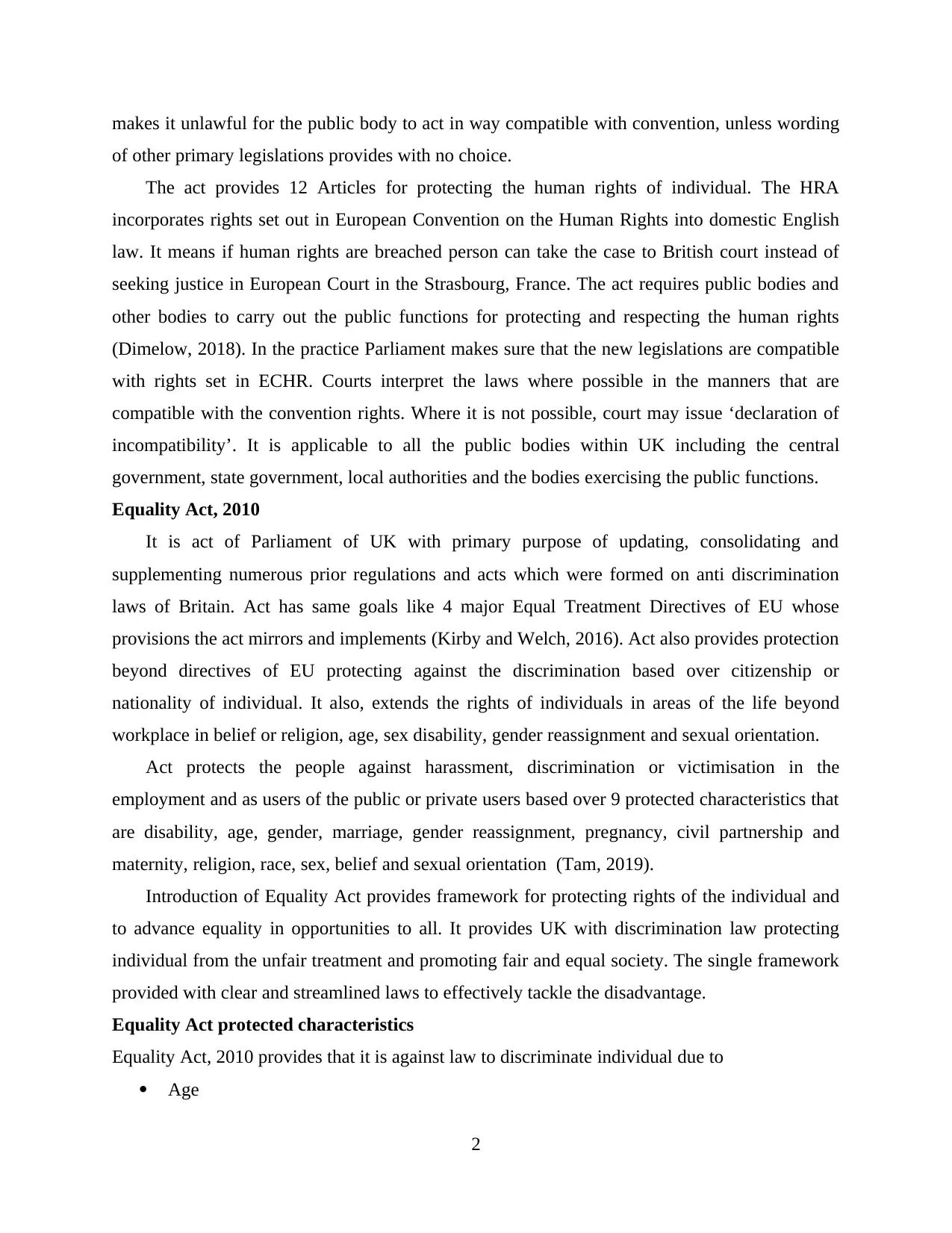
makes it unlawful for the public body to act in way compatible with convention, unless wording
of other primary legislations provides with no choice.
The act provides 12 Articles for protecting the human rights of individual. The HRA
incorporates rights set out in European Convention on the Human Rights into domestic English
law. It means if human rights are breached person can take the case to British court instead of
seeking justice in European Court in the Strasbourg, France. The act requires public bodies and
other bodies to carry out the public functions for protecting and respecting the human rights
(Dimelow, 2018). In the practice Parliament makes sure that the new legislations are compatible
with rights set in ECHR. Courts interpret the laws where possible in the manners that are
compatible with the convention rights. Where it is not possible, court may issue ‘declaration of
incompatibility’. It is applicable to all the public bodies within UK including the central
government, state government, local authorities and the bodies exercising the public functions.
Equality Act, 2010
It is act of Parliament of UK with primary purpose of updating, consolidating and
supplementing numerous prior regulations and acts which were formed on anti discrimination
laws of Britain. Act has same goals like 4 major Equal Treatment Directives of EU whose
provisions the act mirrors and implements (Kirby and Welch, 2016). Act also provides protection
beyond directives of EU protecting against the discrimination based over citizenship or
nationality of individual. It also, extends the rights of individuals in areas of the life beyond
workplace in belief or religion, age, sex disability, gender reassignment and sexual orientation.
Act protects the people against harassment, discrimination or victimisation in the
employment and as users of the public or private users based over 9 protected characteristics that
are disability, age, gender, marriage, gender reassignment, pregnancy, civil partnership and
maternity, religion, race, sex, belief and sexual orientation (Tam, 2019).
Introduction of Equality Act provides framework for protecting rights of the individual and
to advance equality in opportunities to all. It provides UK with discrimination law protecting
individual from the unfair treatment and promoting fair and equal society. The single framework
provided with clear and streamlined laws to effectively tackle the disadvantage.
Equality Act protected characteristics
Equality Act, 2010 provides that it is against law to discriminate individual due to
Age
2
of other primary legislations provides with no choice.
The act provides 12 Articles for protecting the human rights of individual. The HRA
incorporates rights set out in European Convention on the Human Rights into domestic English
law. It means if human rights are breached person can take the case to British court instead of
seeking justice in European Court in the Strasbourg, France. The act requires public bodies and
other bodies to carry out the public functions for protecting and respecting the human rights
(Dimelow, 2018). In the practice Parliament makes sure that the new legislations are compatible
with rights set in ECHR. Courts interpret the laws where possible in the manners that are
compatible with the convention rights. Where it is not possible, court may issue ‘declaration of
incompatibility’. It is applicable to all the public bodies within UK including the central
government, state government, local authorities and the bodies exercising the public functions.
Equality Act, 2010
It is act of Parliament of UK with primary purpose of updating, consolidating and
supplementing numerous prior regulations and acts which were formed on anti discrimination
laws of Britain. Act has same goals like 4 major Equal Treatment Directives of EU whose
provisions the act mirrors and implements (Kirby and Welch, 2016). Act also provides protection
beyond directives of EU protecting against the discrimination based over citizenship or
nationality of individual. It also, extends the rights of individuals in areas of the life beyond
workplace in belief or religion, age, sex disability, gender reassignment and sexual orientation.
Act protects the people against harassment, discrimination or victimisation in the
employment and as users of the public or private users based over 9 protected characteristics that
are disability, age, gender, marriage, gender reassignment, pregnancy, civil partnership and
maternity, religion, race, sex, belief and sexual orientation (Tam, 2019).
Introduction of Equality Act provides framework for protecting rights of the individual and
to advance equality in opportunities to all. It provides UK with discrimination law protecting
individual from the unfair treatment and promoting fair and equal society. The single framework
provided with clear and streamlined laws to effectively tackle the disadvantage.
Equality Act protected characteristics
Equality Act, 2010 provides that it is against law to discriminate individual due to
Age
2
Paraphrase This Document
Need a fresh take? Get an instant paraphrase of this document with our AI Paraphraser
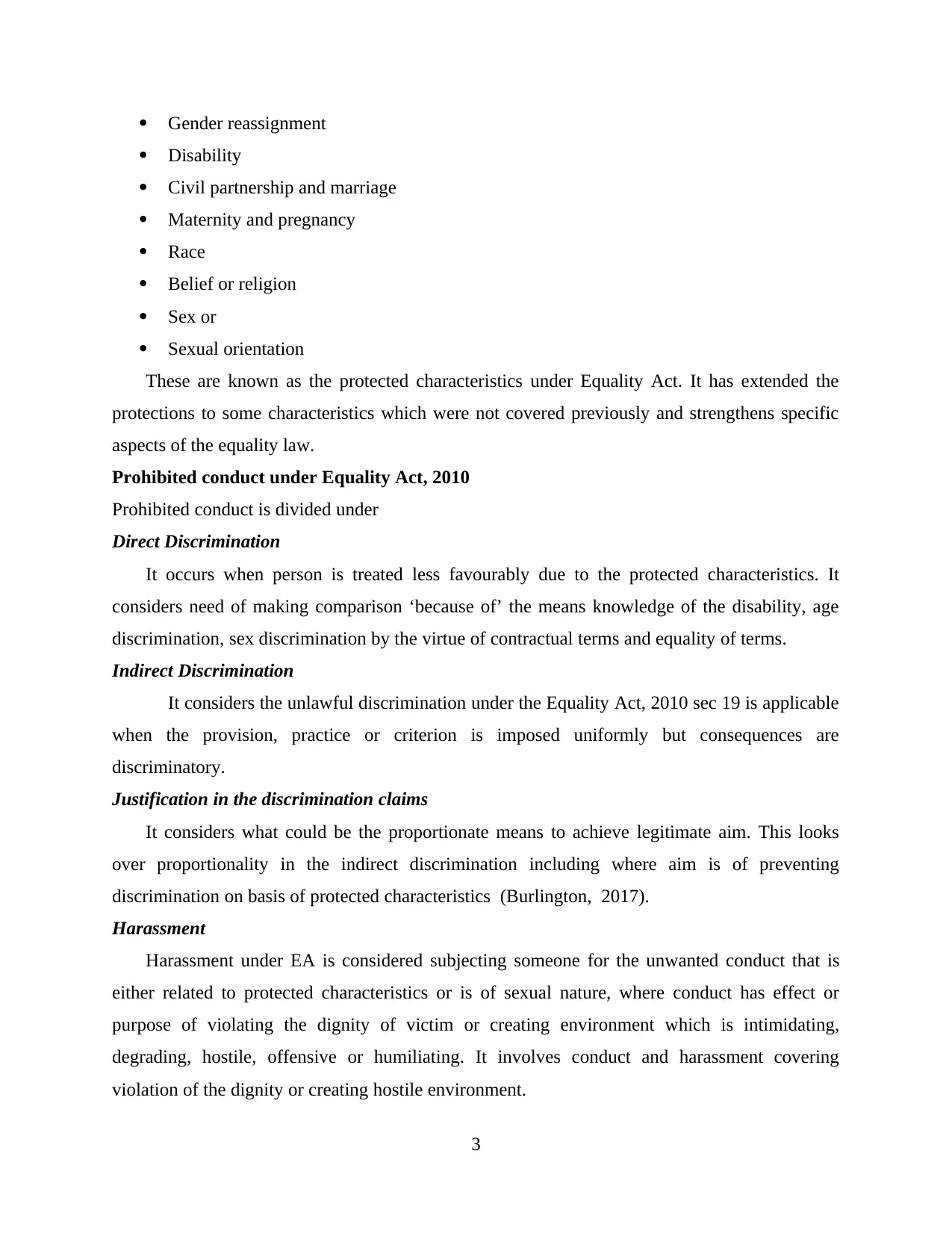
Gender reassignment
Disability
Civil partnership and marriage
Maternity and pregnancy
Race
Belief or religion
Sex or
Sexual orientation
These are known as the protected characteristics under Equality Act. It has extended the
protections to some characteristics which were not covered previously and strengthens specific
aspects of the equality law.
Prohibited conduct under Equality Act, 2010
Prohibited conduct is divided under
Direct Discrimination
It occurs when person is treated less favourably due to the protected characteristics. It
considers need of making comparison ‘because of’ the means knowledge of the disability, age
discrimination, sex discrimination by the virtue of contractual terms and equality of terms.
Indirect Discrimination
It considers the unlawful discrimination under the Equality Act, 2010 sec 19 is applicable
when the provision, practice or criterion is imposed uniformly but consequences are
discriminatory.
Justification in the discrimination claims
It considers what could be the proportionate means to achieve legitimate aim. This looks
over proportionality in the indirect discrimination including where aim is of preventing
discrimination on basis of protected characteristics (Burlington, 2017).
Harassment
Harassment under EA is considered subjecting someone for the unwanted conduct that is
either related to protected characteristics or is of sexual nature, where conduct has effect or
purpose of violating the dignity of victim or creating environment which is intimidating,
degrading, hostile, offensive or humiliating. It involves conduct and harassment covering
violation of the dignity or creating hostile environment.
3
Disability
Civil partnership and marriage
Maternity and pregnancy
Race
Belief or religion
Sex or
Sexual orientation
These are known as the protected characteristics under Equality Act. It has extended the
protections to some characteristics which were not covered previously and strengthens specific
aspects of the equality law.
Prohibited conduct under Equality Act, 2010
Prohibited conduct is divided under
Direct Discrimination
It occurs when person is treated less favourably due to the protected characteristics. It
considers need of making comparison ‘because of’ the means knowledge of the disability, age
discrimination, sex discrimination by the virtue of contractual terms and equality of terms.
Indirect Discrimination
It considers the unlawful discrimination under the Equality Act, 2010 sec 19 is applicable
when the provision, practice or criterion is imposed uniformly but consequences are
discriminatory.
Justification in the discrimination claims
It considers what could be the proportionate means to achieve legitimate aim. This looks
over proportionality in the indirect discrimination including where aim is of preventing
discrimination on basis of protected characteristics (Burlington, 2017).
Harassment
Harassment under EA is considered subjecting someone for the unwanted conduct that is
either related to protected characteristics or is of sexual nature, where conduct has effect or
purpose of violating the dignity of victim or creating environment which is intimidating,
degrading, hostile, offensive or humiliating. It involves conduct and harassment covering
violation of the dignity or creating hostile environment.
3
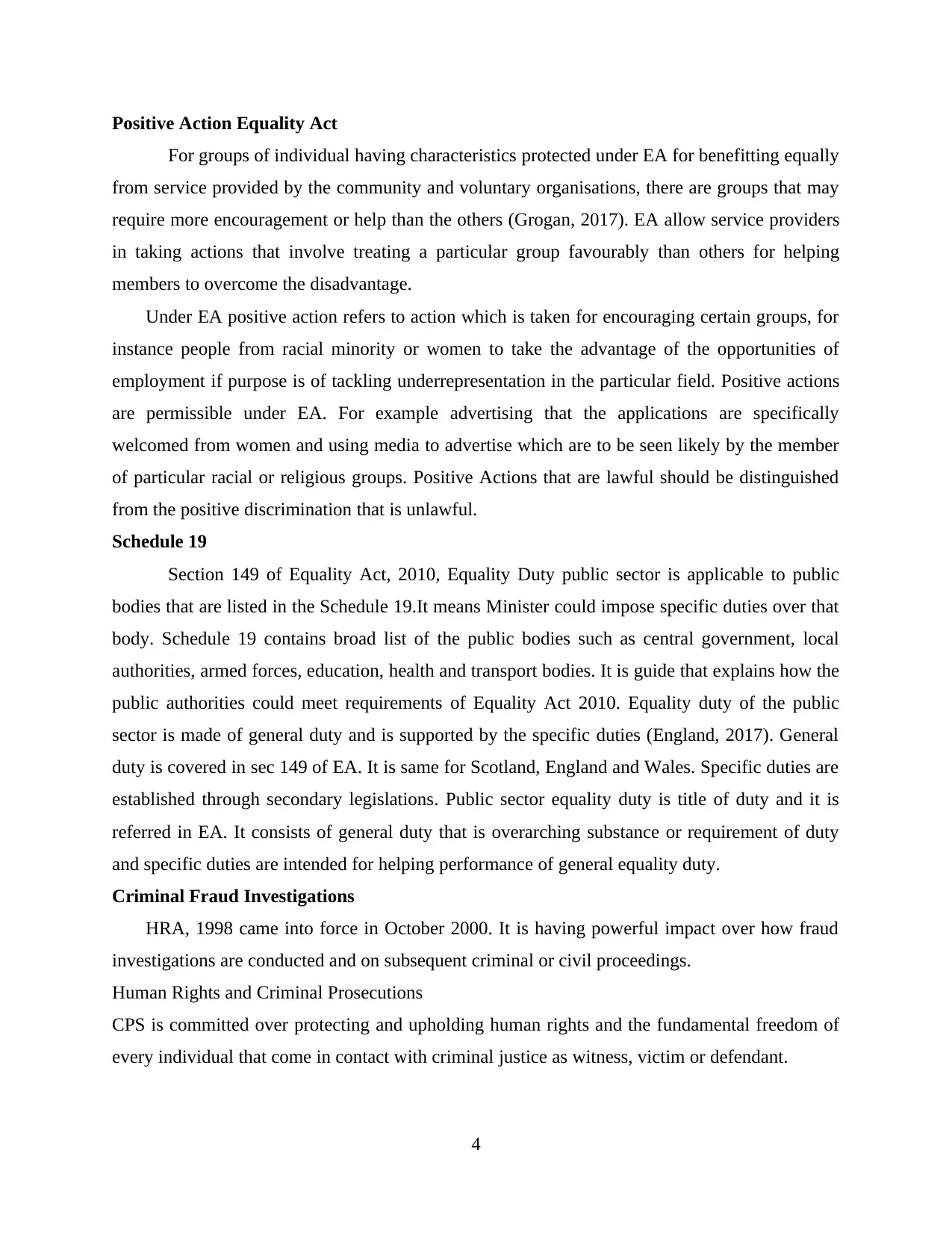
Positive Action Equality Act
For groups of individual having characteristics protected under EA for benefitting equally
from service provided by the community and voluntary organisations, there are groups that may
require more encouragement or help than the others (Grogan, 2017). EA allow service providers
in taking actions that involve treating a particular group favourably than others for helping
members to overcome the disadvantage.
Under EA positive action refers to action which is taken for encouraging certain groups, for
instance people from racial minority or women to take the advantage of the opportunities of
employment if purpose is of tackling underrepresentation in the particular field. Positive actions
are permissible under EA. For example advertising that the applications are specifically
welcomed from women and using media to advertise which are to be seen likely by the member
of particular racial or religious groups. Positive Actions that are lawful should be distinguished
from the positive discrimination that is unlawful.
Schedule 19
Section 149 of Equality Act, 2010, Equality Duty public sector is applicable to public
bodies that are listed in the Schedule 19.It means Minister could impose specific duties over that
body. Schedule 19 contains broad list of the public bodies such as central government, local
authorities, armed forces, education, health and transport bodies. It is guide that explains how the
public authorities could meet requirements of Equality Act 2010. Equality duty of the public
sector is made of general duty and is supported by the specific duties (England, 2017). General
duty is covered in sec 149 of EA. It is same for Scotland, England and Wales. Specific duties are
established through secondary legislations. Public sector equality duty is title of duty and it is
referred in EA. It consists of general duty that is overarching substance or requirement of duty
and specific duties are intended for helping performance of general equality duty.
Criminal Fraud Investigations
HRA, 1998 came into force in October 2000. It is having powerful impact over how fraud
investigations are conducted and on subsequent criminal or civil proceedings.
Human Rights and Criminal Prosecutions
CPS is committed over protecting and upholding human rights and the fundamental freedom of
every individual that come in contact with criminal justice as witness, victim or defendant.
4
For groups of individual having characteristics protected under EA for benefitting equally
from service provided by the community and voluntary organisations, there are groups that may
require more encouragement or help than the others (Grogan, 2017). EA allow service providers
in taking actions that involve treating a particular group favourably than others for helping
members to overcome the disadvantage.
Under EA positive action refers to action which is taken for encouraging certain groups, for
instance people from racial minority or women to take the advantage of the opportunities of
employment if purpose is of tackling underrepresentation in the particular field. Positive actions
are permissible under EA. For example advertising that the applications are specifically
welcomed from women and using media to advertise which are to be seen likely by the member
of particular racial or religious groups. Positive Actions that are lawful should be distinguished
from the positive discrimination that is unlawful.
Schedule 19
Section 149 of Equality Act, 2010, Equality Duty public sector is applicable to public
bodies that are listed in the Schedule 19.It means Minister could impose specific duties over that
body. Schedule 19 contains broad list of the public bodies such as central government, local
authorities, armed forces, education, health and transport bodies. It is guide that explains how the
public authorities could meet requirements of Equality Act 2010. Equality duty of the public
sector is made of general duty and is supported by the specific duties (England, 2017). General
duty is covered in sec 149 of EA. It is same for Scotland, England and Wales. Specific duties are
established through secondary legislations. Public sector equality duty is title of duty and it is
referred in EA. It consists of general duty that is overarching substance or requirement of duty
and specific duties are intended for helping performance of general equality duty.
Criminal Fraud Investigations
HRA, 1998 came into force in October 2000. It is having powerful impact over how fraud
investigations are conducted and on subsequent criminal or civil proceedings.
Human Rights and Criminal Prosecutions
CPS is committed over protecting and upholding human rights and the fundamental freedom of
every individual that come in contact with criminal justice as witness, victim or defendant.
4
⊘ This is a preview!⊘
Do you want full access?
Subscribe today to unlock all pages.

Trusted by 1+ million students worldwide
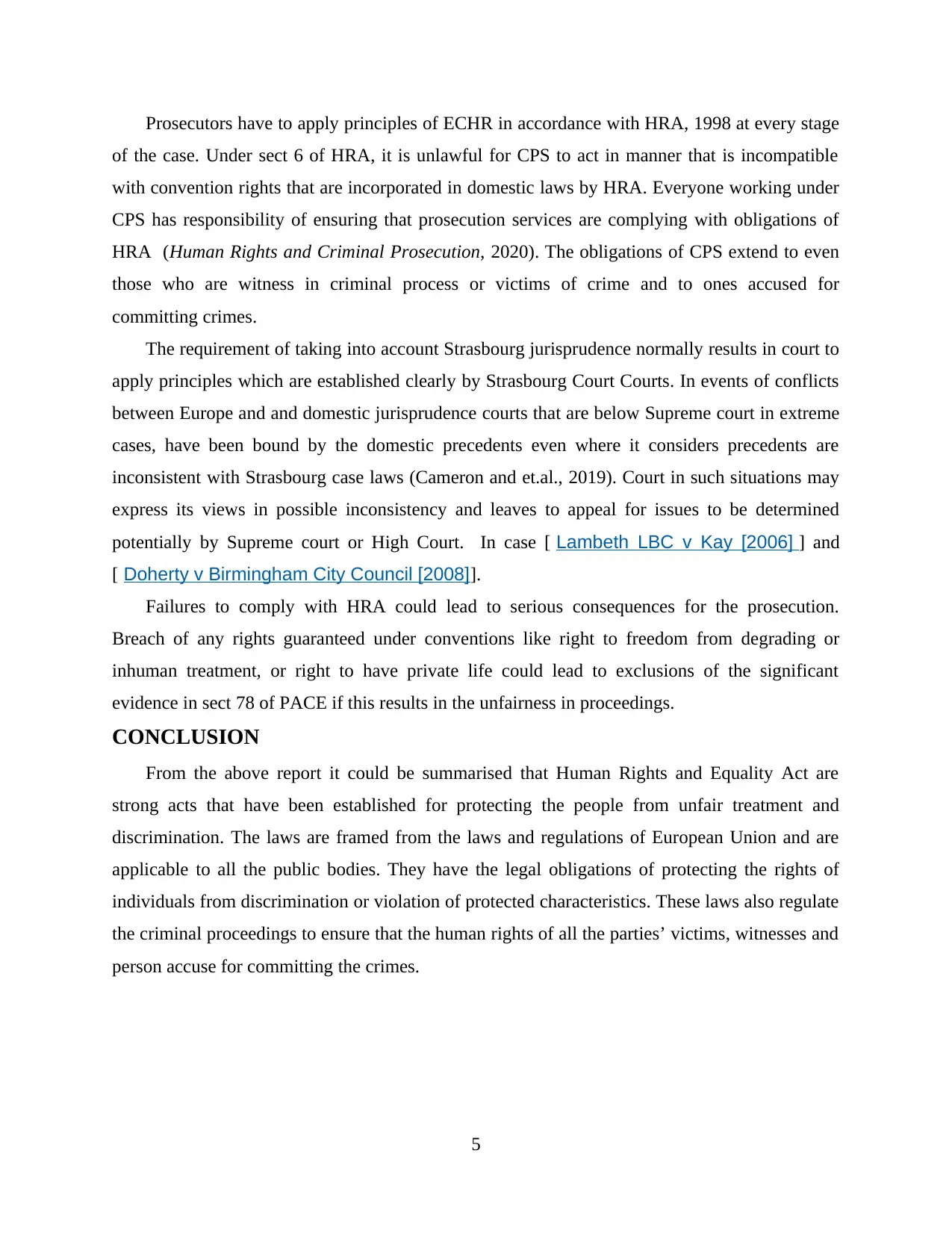
Prosecutors have to apply principles of ECHR in accordance with HRA, 1998 at every stage
of the case. Under sect 6 of HRA, it is unlawful for CPS to act in manner that is incompatible
with convention rights that are incorporated in domestic laws by HRA. Everyone working under
CPS has responsibility of ensuring that prosecution services are complying with obligations of
HRA (Human Rights and Criminal Prosecution, 2020). The obligations of CPS extend to even
those who are witness in criminal process or victims of crime and to ones accused for
committing crimes.
The requirement of taking into account Strasbourg jurisprudence normally results in court to
apply principles which are established clearly by Strasbourg Court Courts. In events of conflicts
between Europe and and domestic jurisprudence courts that are below Supreme court in extreme
cases, have been bound by the domestic precedents even where it considers precedents are
inconsistent with Strasbourg case laws (Cameron and et.al., 2019). Court in such situations may
express its views in possible inconsistency and leaves to appeal for issues to be determined
potentially by Supreme court or High Court. In case [ Lambeth LBC v Kay [2006] ] and
[ Doherty v Birmingham City Council [2008]].
Failures to comply with HRA could lead to serious consequences for the prosecution.
Breach of any rights guaranteed under conventions like right to freedom from degrading or
inhuman treatment, or right to have private life could lead to exclusions of the significant
evidence in sect 78 of PACE if this results in the unfairness in proceedings.
CONCLUSION
From the above report it could be summarised that Human Rights and Equality Act are
strong acts that have been established for protecting the people from unfair treatment and
discrimination. The laws are framed from the laws and regulations of European Union and are
applicable to all the public bodies. They have the legal obligations of protecting the rights of
individuals from discrimination or violation of protected characteristics. These laws also regulate
the criminal proceedings to ensure that the human rights of all the parties’ victims, witnesses and
person accuse for committing the crimes.
5
of the case. Under sect 6 of HRA, it is unlawful for CPS to act in manner that is incompatible
with convention rights that are incorporated in domestic laws by HRA. Everyone working under
CPS has responsibility of ensuring that prosecution services are complying with obligations of
HRA (Human Rights and Criminal Prosecution, 2020). The obligations of CPS extend to even
those who are witness in criminal process or victims of crime and to ones accused for
committing crimes.
The requirement of taking into account Strasbourg jurisprudence normally results in court to
apply principles which are established clearly by Strasbourg Court Courts. In events of conflicts
between Europe and and domestic jurisprudence courts that are below Supreme court in extreme
cases, have been bound by the domestic precedents even where it considers precedents are
inconsistent with Strasbourg case laws (Cameron and et.al., 2019). Court in such situations may
express its views in possible inconsistency and leaves to appeal for issues to be determined
potentially by Supreme court or High Court. In case [ Lambeth LBC v Kay [2006] ] and
[ Doherty v Birmingham City Council [2008]].
Failures to comply with HRA could lead to serious consequences for the prosecution.
Breach of any rights guaranteed under conventions like right to freedom from degrading or
inhuman treatment, or right to have private life could lead to exclusions of the significant
evidence in sect 78 of PACE if this results in the unfairness in proceedings.
CONCLUSION
From the above report it could be summarised that Human Rights and Equality Act are
strong acts that have been established for protecting the people from unfair treatment and
discrimination. The laws are framed from the laws and regulations of European Union and are
applicable to all the public bodies. They have the legal obligations of protecting the rights of
individuals from discrimination or violation of protected characteristics. These laws also regulate
the criminal proceedings to ensure that the human rights of all the parties’ victims, witnesses and
person accuse for committing the crimes.
5
Paraphrase This Document
Need a fresh take? Get an instant paraphrase of this document with our AI Paraphraser
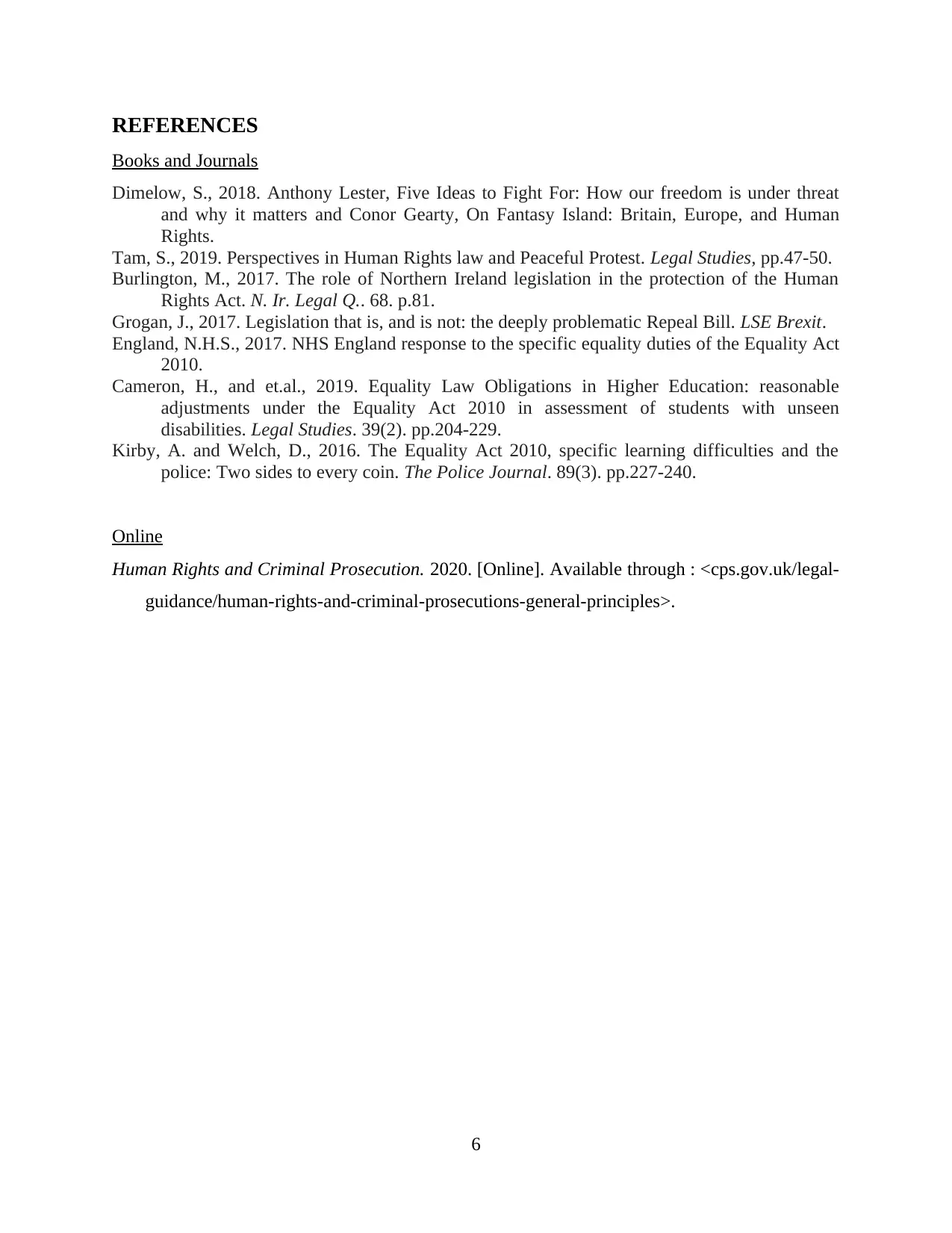
REFERENCES
Books and Journals
Dimelow, S., 2018. Anthony Lester, Five Ideas to Fight For: How our freedom is under threat
and why it matters and Conor Gearty, On Fantasy Island: Britain, Europe, and Human
Rights.
Tam, S., 2019. Perspectives in Human Rights law and Peaceful Protest. Legal Studies, pp.47-50.
Burlington, M., 2017. The role of Northern Ireland legislation in the protection of the Human
Rights Act. N. Ir. Legal Q.. 68. p.81.
Grogan, J., 2017. Legislation that is, and is not: the deeply problematic Repeal Bill. LSE Brexit.
England, N.H.S., 2017. NHS England response to the specific equality duties of the Equality Act
2010.
Cameron, H., and et.al., 2019. Equality Law Obligations in Higher Education: reasonable
adjustments under the Equality Act 2010 in assessment of students with unseen
disabilities. Legal Studies. 39(2). pp.204-229.
Kirby, A. and Welch, D., 2016. The Equality Act 2010, specific learning difficulties and the
police: Two sides to every coin. The Police Journal. 89(3). pp.227-240.
Online
Human Rights and Criminal Prosecution. 2020. [Online]. Available through : <cps.gov.uk/legal-
guidance/human-rights-and-criminal-prosecutions-general-principles>.
6
Books and Journals
Dimelow, S., 2018. Anthony Lester, Five Ideas to Fight For: How our freedom is under threat
and why it matters and Conor Gearty, On Fantasy Island: Britain, Europe, and Human
Rights.
Tam, S., 2019. Perspectives in Human Rights law and Peaceful Protest. Legal Studies, pp.47-50.
Burlington, M., 2017. The role of Northern Ireland legislation in the protection of the Human
Rights Act. N. Ir. Legal Q.. 68. p.81.
Grogan, J., 2017. Legislation that is, and is not: the deeply problematic Repeal Bill. LSE Brexit.
England, N.H.S., 2017. NHS England response to the specific equality duties of the Equality Act
2010.
Cameron, H., and et.al., 2019. Equality Law Obligations in Higher Education: reasonable
adjustments under the Equality Act 2010 in assessment of students with unseen
disabilities. Legal Studies. 39(2). pp.204-229.
Kirby, A. and Welch, D., 2016. The Equality Act 2010, specific learning difficulties and the
police: Two sides to every coin. The Police Journal. 89(3). pp.227-240.
Online
Human Rights and Criminal Prosecution. 2020. [Online]. Available through : <cps.gov.uk/legal-
guidance/human-rights-and-criminal-prosecutions-general-principles>.
6
1 out of 8
Related Documents
Your All-in-One AI-Powered Toolkit for Academic Success.
+13062052269
info@desklib.com
Available 24*7 on WhatsApp / Email
![[object Object]](/_next/static/media/star-bottom.7253800d.svg)
Unlock your academic potential
Copyright © 2020–2025 A2Z Services. All Rights Reserved. Developed and managed by ZUCOL.




